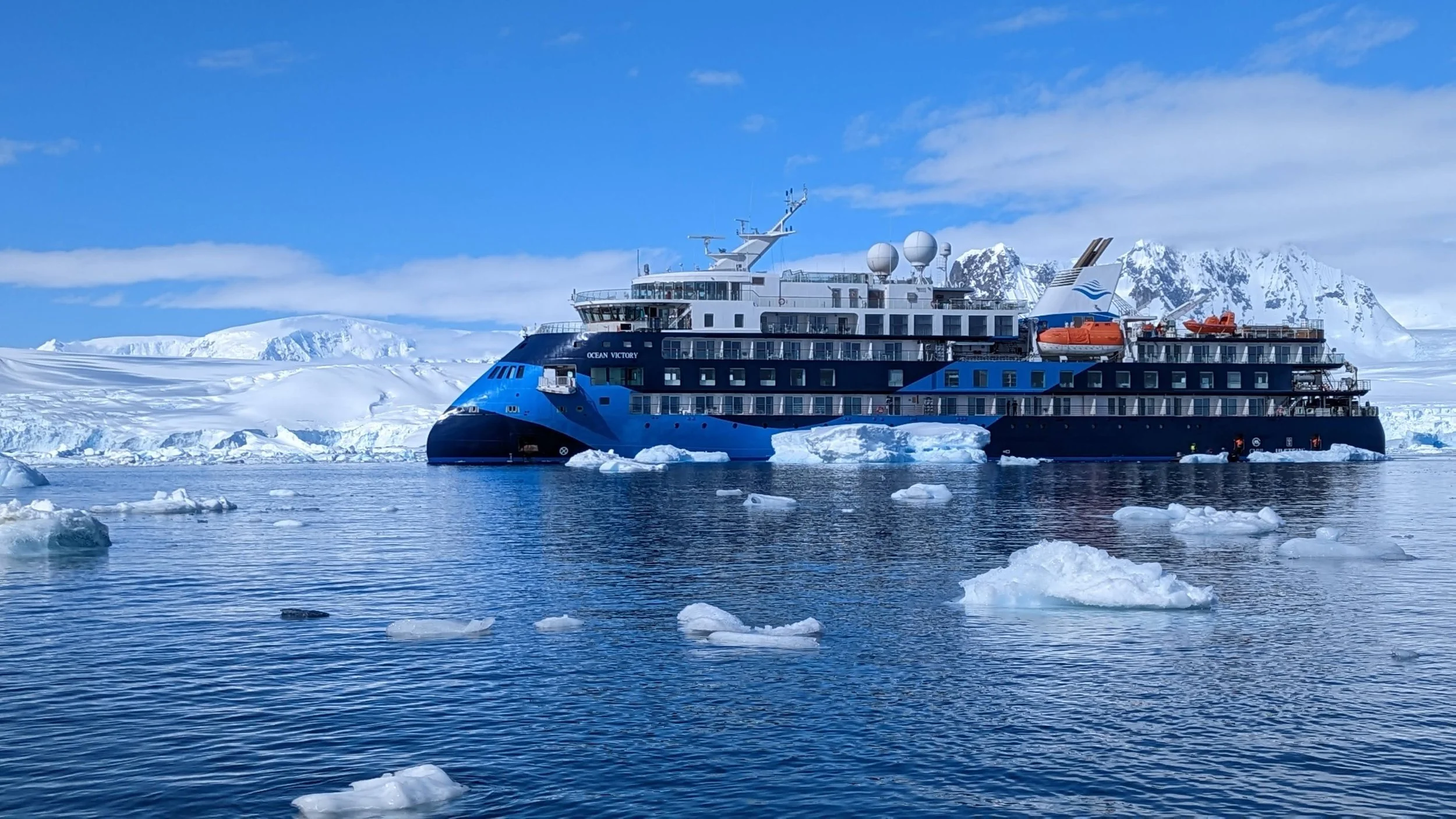Our Guide to Cruising in Antarctica: Best Cruise Lines and Ship Styles
I’ve been on four expedition cruises to Antarctica, and I think they are perfect for adventurous travelers who want to go on fun hikes and kayaking outings to see fascinating wildlife. (Photo by John Roberts)
Antarctica offers so much to see for adventurous travelers, with its towering icebergs, bustling penguin colonies and serene and spectacularly scenic landscapes.
Each year, from November to March, dozens of cruise lines bring thousands of people to the Antarctic Peninsula and South Georgia Island.
Travel to this special destination is governed by the International Association of Antarctica Tour Operators (IAATO), and only ships with 500 or fewer passengers are allowed to make landings (bringing travelers ashore). This rule is designed to limit environmental impact.
However, some cruise lines offer offer scenic cruises from afar on their bigger ships — so travelers can at least get a glimpse of the region and its landscapes, as well as any whales, seabirds and other creatures that can be seen from the ship.
Let’s take a look at the cruise lines — from large cruise ships to small expedition vessels — that offer cruises to Antarctica so you can have an idea of what’s available and figure out what appeals to you for your ultimate Antarctica cruise vacation.
Albatros Expeditions offers cruises to Antarctica on the ship Ocean Victory. Ships that carry fewer than 200 passengers can bring you right to the continent for intimate experiences. (Photo by John Roberts)
Small Expedition Ships (Fewer than 200 Cruisers): Intimate Immersion
These smaller ships, like those from Atlas Ocean Voyages (World Navigator, World Traveller and World Voyager) and Lindblad Expeditions-National Geographic (National Geographic Explorer), feature immersive experiences. Atlas Ocean Voyages offer sailings on its 196-passenger luxury yachts that blend adventure, education and comfortable cuisine. Atlas ships have amenities like a hot tub, swimming pool, spa and gym, plus wonderful food and service.
All of the expedition lines have voyages led by passionate guides who give great insight into the region’s history and wildlife while leading Zodiac cruises and hikes.
Pros of Small-Ship Antarctica Cruises
Unparalleled Access: Smaller ship size allows navigation into the narrow fjords and remote bays that are inaccessible to larger ships, maximizing wildlife encounters — think close-up views of humpback whales breaching or Adélie penguins waddling ashore.
Frequent Landings: With a maximum of 100 passengers per group, you'll spend more time off your ship (up to two to three hours per site and typically two landings per day). You also won’t be frustrated in long queue waiting for Zodiacs.
The captains and crew also have more flexibility in adjusting the route to get you to the optimum spots in most weather conditions.
Personal Touch: High guide-to-cruiser ratios (1:10 or better) allow for better interactions and more learning. Guides can answer your questions one on one or during the frequent lectures and enrichment talks that cover a range of subjects, such as history, marine birds, whales, conservation, penguins and more. Also, socially, it's easy to bond with fellow active travelers during drinks and meals.
More Eco-Friendly: The lower passenger counts on these expeditions minimizes the impact of humans in these spots. Many cruises, like those from G Adventures' Expedition (149 guests), incorporate citizen science, such as seabird surveys.
Cons of Small-Ship Expedition Cruising
Rougher Ride: The smaller ships typically offer less stabilization than the mega ships, so the Drake Passage crossing can feel like a rollercoaster. This is a fun adventure if you’re up for it, but also can be tough for travelers susceptible to seasickness.
Limited Amenities and Higher Price: Expect cozy cabins and basic facilities on most small ships. There will be no rock-climbing walls or multiple pools. Prices start at $8,000 to $15,000 per person for a 10- to 12-day voyage.
Intense Pace: Daily excursions demand fitness; it's adventure over relaxation, with little downtime until late afternoon and into the evening. Cruisers generally head to bed pretty soon after dinner to rest up and be ready for the next day’s adventures.
Operators like Aurora Expeditions (Greg Mortimer, 120 cruisers) and Poseidon Expeditions (Sea Spirit, 116 people) exemplify this style, offering active itineraries with kayaking and camping.
Also read Our Ultimate Packing Guide for a Cruise to Antarctica.
Mid-Sized Expedition Ships (200 to 500 passengers): Balanced Comfort
HX (MS Fram, MS Roald Amundsen) and Ponant (Le Commandant Charcot, an icebreaker) combine memorable adventures and luxury. HX uses hybrid-electric ships for sustainable cruising. Ponant's Le Commandant Charcot has a Polar Class 2 ice rating, meaning it’s the most powerful ice breaking passenger ship, allowing for rare itineraries you won’t find on any other ships.
Pros of Mid-Sized Antarctic Cruises
Enhanced Facilities: Stabilizers smooth the journey, while features like gyms, lectures and fine dining elevate comfort. You can find many of these elements on smaller ships, too, but they tend to be elevated and standard features on mid-sized luxury expedition voyages in Antarctica.
For example, Ponant’s French flair includes Michelin-inspired cuisine and a full menu of spa treatments.
Scalable Landings: The excursions still are compliant with IAATO's 100-person limit, but multiple Zodiac teams allow broader participation; this is ideal for families or mixed fitness levels.
Value and Variety: You’ll find more onboard entertainment (HX features citizen science labs) and cruises fares ranging from $6,000 to $12,000 per person. Also, ice-strengthened hulls enable earlier and later season trips for calving glaciers.
Community Vibe: Larger groups foster diverse interactions, with options for solos or couples.
Cons of Mid-Size Ships in Antarctica
Crowd Dynamics: The rotations for more landing groups mean less time ashore and longer waits.
Higher Cruise Fares Are Possible: Premium features can inflate fares a bit, and these sailings might have a less-intimate feel than the smaller ships.
Compromised Flexibility: Bigger drafts limit some shallow-water access, meaning that the vessels tend to stick to main peninsula routes.
Viking expedition ships (Viking Octantis and Viking Polaris, each carrying up to 378 people) fit in this category, blending Nordic design with amenities like submarines for underwater views.
You also can check out ultra-high-end all-inclusive cruises from Silversea (Silver Endeavour, 220 passengers) and Scenic Cruises (Scenic Eclipse and Scenic Eclipse II, 200 cruisers), which include 5-star perks. Scenic’s ships feature helicopters for aerial ice tours, as well as submarines.
Mega Cruise Ships (More than 500 passengers):
Just Passing By
Large cruise ships from mainstream lines such as Norwegian Cruise Line, Princess Cruises, Holland America and Celebrity Cruises circle the peninsula without landings.
These voyages sail past locations like the Antarctic Peninsula, Elephant Island, and Deception Island to give travelers a look at Antarctica and the surrounding waters but with no opportunity to setting foot on the continent, which is of ultimate importance for some people.
Pros of Cruise to Antarctica on a Big Ship
Affordability and Scale: These trips can be much more budget-friendly — ranging in cost from $1,500 to $4,000 per person — while also featuring a huge range of amenities and activities, such as Broadway-style shows, live music, casinos, pools and multiple shops and restaurants.
Stability and Entertainment: The huge ships have stabilizer systems that allow them to transit the Drake effortlessly. You’ll still feel the waves, but they typically don’t feel as turbulent. Cruisers also enjoy a wide range of onboard lectures and do plenty of whale- and bird-watching from the outer deck areas.
Family Travel to the White Continent: With the affordability and variety of activities, this style is ideal for families to take their trip to Antarctica.
Cons of Taking a Big Cruise Ship to Antarctica
No Landings: IAATO rules prohibit shore access from these large groups and big ships, so you’re simply a spectator in the area, missing penguin interactions or hikes. You might end up feeling somewhat detached from Antarctica.
Crowds and Commercial Feel: Having thousands of passengers onboard with you doesn’t allow for a siren and intimate connection to nature. Also, environmental concerns rise with higher emissions from big ships in these sensitive regions.


